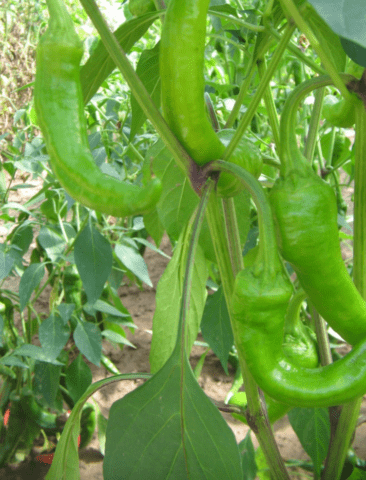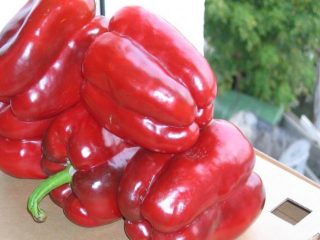Content
Lamb's horn pepper is a variety with a pleasant hot taste and spicy aroma. It has a high yield - 3 kg of fruit can be harvested from 1 m². The pods have an interesting shape, truly reminiscent of a horn. The color is dark red, attractive.
History of appearance
Ram's horn is a variety of hot pepper, bred in Russia by a team of breeders: Ognev V.V., Klimenko N.N., Maksimov S.V., Kostenko A.N. The application for admission was submitted in 2012, in the same year the crop was included in the register of breeding achievements of Russia. The originators are: Agrofirm Poisk LLC and the Federal Scientific Center for Vegetable Growing.
Description of the Ram's Horn pepper variety
The variety is a medium-sized bush. The plant is quite compact.Ripens in 3.5-4 months, the fruits are dark red, with a very pungent taste.
Sharpness, weight and shape of fruits
Ram's horn peppers are drooping, elongated, the surface is slightly wrinkled. They bend strongly like a trunk, and the tip makes another bend in the opposite direction, which is what the name of the variety is associated with. Average weight 15-25 g, diameter up to 3 cm. At the stage of technical ripeness, the color is pale green, whitish. As the fruits ripen, they become a rich dark red color.
The cut shows 2-3 nests with seeds. They can be harvested for planting next season because Ram's Horn is a variety and not a hybrid. The wall is 1.5-2.0 mm thick. The taste is very spicy, so this pepper can be added to dishes in small quantities. There is a pleasant spicy aroma.
Universal purpose:
- fresh consumption (in dishes);
- drying;
- pickling;
- getting seasonings.

The harvest has time to ripen on the branch
Height and size of the bush
Ram's Horn pepper bushes are medium-sized, close-knit. The leaves are medium-sized, green in color, with a slightly wrinkled surface. The plant reaches a height of 50-60 cm, although in a greenhouse it often reaches 100-110 cm. The bushes do not spread out, which saves space when planting.
Characteristics of bitter pepper Ram's horn
Ram's Horn pepper has good yield - even from a small bed of 2 m22 you can collect 5-6 kg of fruit, which is quite enough for the needs of a personal household. The plant is resistant to waterlogging; fruits form normally even in rainy weather.
Pepper yield Ram's horn
The crop yield is 3 kg per square meter. Each bush produces 50-60 fruits.This indicator can be achieved in any region when grown under film cover and subject to the basic rules of agricultural technology. During cold seasons, yields may decrease slightly.
Fruiting dates
According to the ripening period, Ram's Horn pepper belongs to the mid-season (medium) varieties. From the moment of mass emergence of seedlings to the stage of technical ripeness, 110-120, maximum 130-150 days pass. The fruits have time to ripen on the bush, fruiting is long and extended. The main wave occurs in July, and the first peppers can be harvested at the end of June.
Disease resistance
Disease resistance is average. The plant may suffer from phytoplasmosis, late blight, and bronze disease. An invasion of aphids, wireworms, spider mites and other pests is possible. Therefore, it is necessary to carry out preventive treatments and periodically inspect the bushes for the presence of insects.
Growing regions
The register of breeding achievements notes that the Ram's Horn pepper variety is approved for cultivation in most Russian regions, including:
- middle zone, Moscow region;
- Volga region;
- Chernozem region;
- southern regions;
- Northwest;
- Ural;
- Western and Eastern Siberia;
- Far East.
Advantages and disadvantages
The Ram's Horn variety is valued for its high yield and rich, pungent taste. Red pepper can be used to prepare any winter dishes.

The yield is consistently high even in cool weather
Pros:
- very pungent taste;
- attractive appearance;
- universal fruits;
- increased productivity;
- fruiting is extended;
- You can harvest the seeds yourself.
Minuses:
- seedlings are sensitive to transplantation and cannot be picked;
- drought tolerance;
- weak immunity to diseases.
Features of growing bitter pepper Ram's horn
Peppers of this variety require care, especially regular watering. You also need to fertilize and loosen the soil. Then the harvest will be really good.
When and how to plant Ram's Horn pepper for seedlings
Seedlings are traditionally one of the first to be planted because the seeds must first be germinated. Therefore, work should begin in the second half of February and no later than the first days of May.
Instructions for growing Ram's Horn pepper seedlings are as follows:
- Select and germinate seeds on damp cotton wool, in sawdust or in another way.
- Plant 2-3 seeds in peat pots or tablets.
- Place in a warm place (26-28 degrees), moisten.
- Cover with film and install lighting.
- After the shoots appear, remove the film, leave one seedling, and pinch the rest.
- 10-15 days before transplanting into the ground, periodically take the seedlings out into the open air for hardening.
Transplantation into open ground
Ram's Horn pepper seedlings are transplanted into open ground in the middle or second half of May. Seedlings can be transferred to a greenhouse or under a film cover at the beginning of the month. In this case, the soil temperature should not be lower than 14-15 degrees.
Before planting, the soil must be dug up and fertilized with organic matter (compost, humus) or complex mineral fertilizer. The depth of the holes is up to 8-10 cm, the interval between rows is 50 cm, and between plants - 30 cm.Since the bushes are not spreading, 4-5 seedlings can be placed per 1 m².
The weather should be cloudy, as bright sunlight can have a bad effect on unprepared plants

Seedlings are transplanted into open ground in the second half of May.
Further care
To get a good harvest of Ram's Horn pepper, experienced summer residents recommend following these tips:
- Regular watering at the root twice a week, in drought - three times. The water is infused in advance so that it becomes room temperature.
- Fertilizing is applied 4-5 times per season. The first time is given a week after transplanting the seedlings, and then every 10 days. The best option is alternating complex mineral fertilizers with organic matter.
- After watering, the soil is loosened and weeded.
- Plantings are mulched with straw, wood chips, and sawdust.
Prevention of diseases and pests
To prevent late blight and other fungal infections, it is recommended to treat Ram Horn pepper seedlings with a fungicide a few days after transplanting. To do this, you can use any of the following drugs:
- "HOM";
- "Quadris";
- "Fundazol";
- "Ordan".
If the disease appears during fruiting, it is advisable to use biological fungicides, for example, Respecta 25 or Fitosporin.
To protect bushes from insects, insecticides are used:
- "Biotlin";
- "Aktara";
- "Decis";
- "Confidor" and others.
During fruiting, biological preparations (Fitoverm, Vertimek) or folk remedies (infusion of tobacco dust, wood ash, wormwood, celandine and others) are used.

During the fruiting period, plants are treated with biological preparations or folk remedies
If peppers are grown in open ground, processing is done in dry and windless weather.
Conclusion
Ram's Horn pepper is one of the best varieties that can be cultivated in almost any region. Requires regular watering and fertilizing. If agricultural practices are followed, it produces a stable harvest even in cool and rainy summers.
Reviews from gardeners about Ram's Horn pepper








